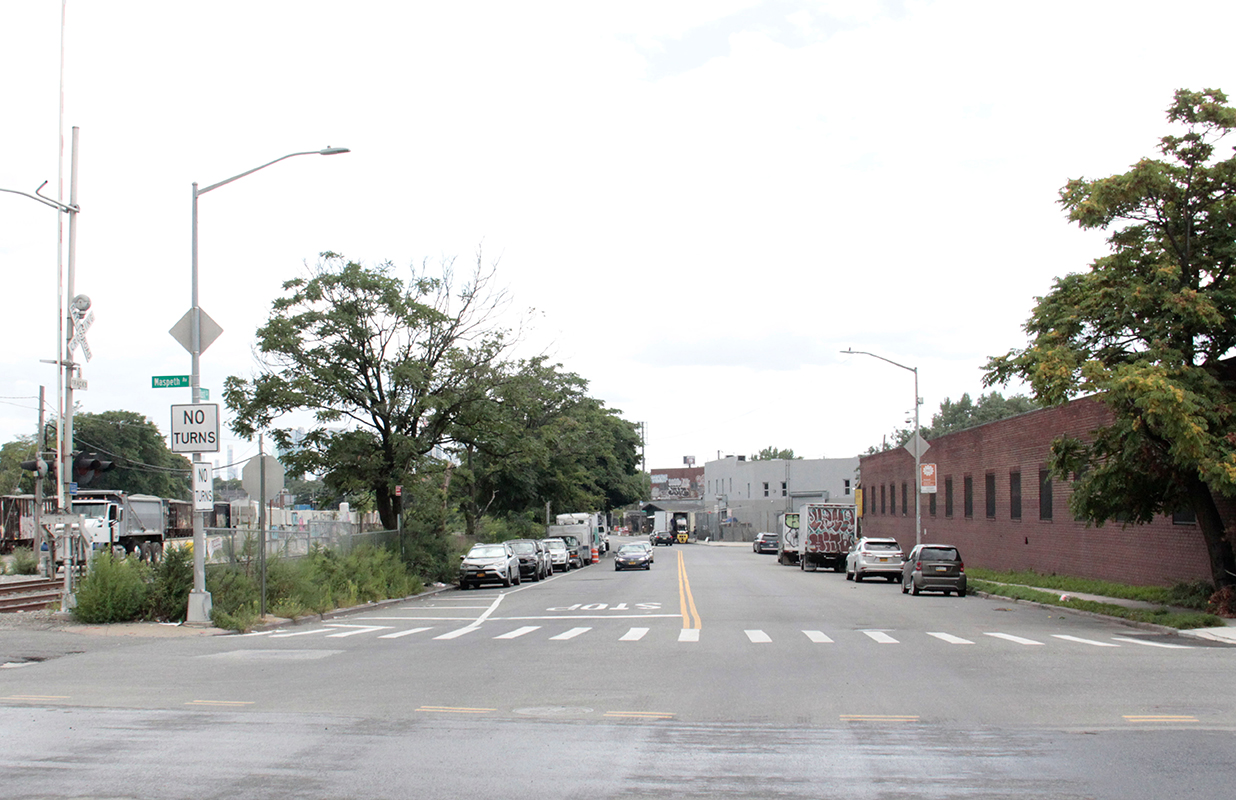

To support economic opportunity and reduce climate impacts, establish Green Industrial Cooperatives at industrial business zones.
By Gary Chung, Eleanor Gibson, Earl Lin, Candelaria Mas Pohmajevic, Jenny Osman, Saritha Ramakrishna, Zeineb Sellami, Matthew Seybert, Kristin Sposito
The Need
New York City’s industrial zones have historically posed harmful environmental impacts. Many of these districts are notorious for being heat islands, where temperatures can rise to 13 degrees higher than adjacent neighborhoods due to emissions from trucks and machinery, blacktop surfaces, and limited greenery.(1) These areas also have a legacy of pollution, with contaminated waterways and soils requiring expensive remediation – barriers to their sustainable redevelopment.
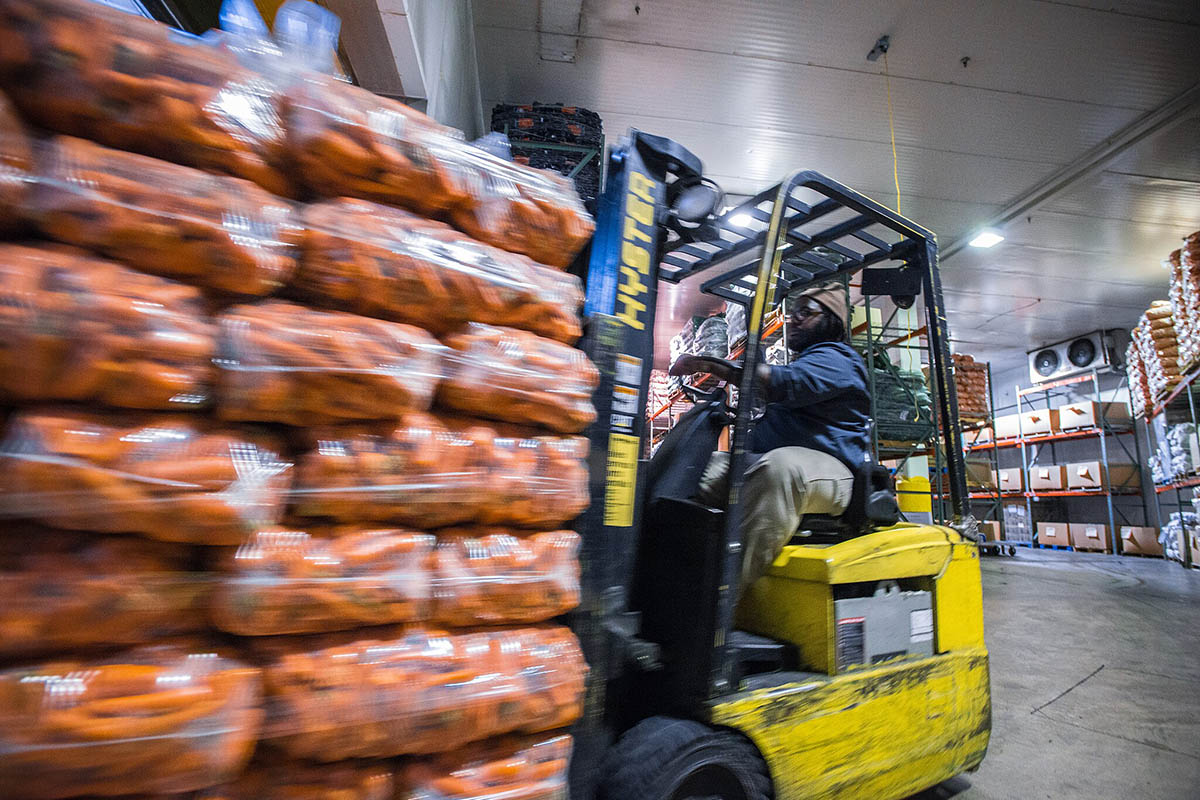
However, industrial businesses have long been vital in providing essential goods, services, and jobs to the region. These zones have supported economic diversity through low-barrier employment, predominantly for immigrant and minority populations. Despite efforts to protect these areas – such as the 2006 designation of Industrial Business Zones (IBZs) – the manufacturing sector continues to shrink. Today, New York City’s manufacturing jobs have declined to around 57,000, down from 120,000 nearly two decades ago, largely due to high operational costs and real estate pressures. (2) (3)
To help meet citywide and global climate goals, the City could reimagine ecosystems of industrial businesses, particularly in the construction sector. With recent city frameworks such as Local Law No. 172 of 2023, which mandates an industrial development strategic plan, and the NYCEDC’s Green Economy Action Plan, there is an opportunity to transform these areas into assets that promote economic growth while reducing carbon emissions.
The Vision
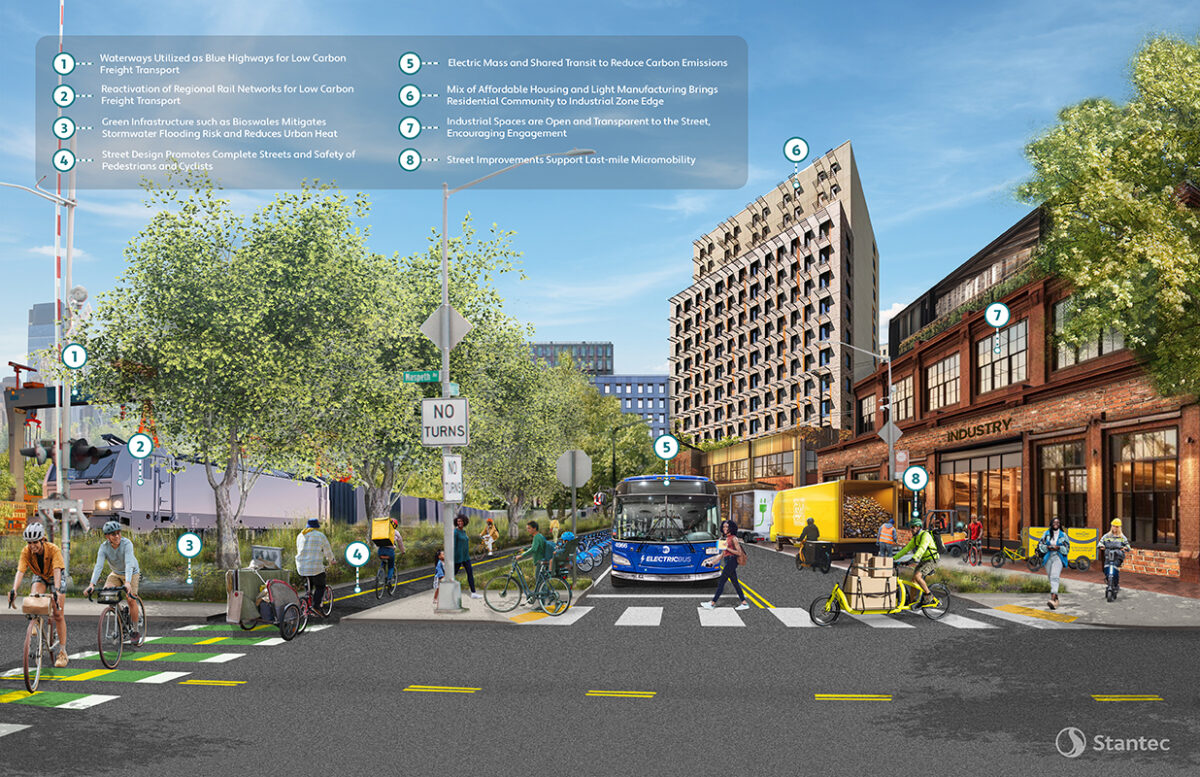
To support economic opportunity and reduce climate impacts in New York City’s construction and building sectors, the City could establish Green Industrial Cooperatives (GICs). In line with the City’s goal to halve waste by 2033, GICs would enable a network of interconnected businesses to promote circular construction practices citywide.
During the initial implementation phase, the Department of Small Business Services could engage with industrial stakeholders within each IBZ to determine a cooperative governance framework that best suits the community. These cooperatives could take the form of member-owned purchasing cooperatives – similar to Hunts Point Coop Market or Amicus Solar Cooperative, which support a range of different businesses – or form as a single worker-owned cooperative.
Regardless of the governance framework, the cooperative model would support principles of economic democracy and ensure equitable economic and environmental benefits for local workers and community members. Moreover, it would streamline operations by pooling resources, helping businesses achieve economies of scale, and lowering operational costs for back-office support and purchasing services.
The following strategies could be implemented to shape a construction material reuse economy with Green Industrial Cooperatives (GIC) within IBZs:
→
Build a market for material reuse in the building construction industry.
- Develop a shared and dynamic database for industrial businesses of refuse materials and byproducts to support the reuse of construction waste and improve supply chain resilience.
- Develop an accelerator program to support small businesses, foster innovation, and stimulate demand in new markets for material reuse.
- Work with NYCEDC to develop local procurement policies and incentives for circular design. By scaling NYCEDC’s Circular Construction Guidelines, city agencies could begin to foster a market for sustainable materials and construction.
→
Support education and training of businesses and workers around material reuse and energy sustainability.
- Share workforce training opportunities among businesses to reduce the overall cost of human resources.
- Develop a training hub to inform architects, builders, demolition contractors, and suppliers for creating a reclaimed building materials marketplace.
- Establish an accelerator program for small businesses and manufacturers that educate and prepare local businesses to apply for grants and programs.
- Equip businesses with tools to measure and reduce emissions, such as Internal Carbon Pricing and other innovative carbon reduction strategies.
- Create partnerships with public and mission-oriented private investors to boost green jobs generation and business innovation.
→
Support long-term neighborhood planning and sustainable infrastructure investments.
- Identify public sites to establish reuse warehouses for accepting, storing, and selling reclaimed building materials managed by a GIC.
- Advocate for a shift to low-carbon local and regional transport of materials and goods through micro-mobility, “blue highways” or the reactivation of existing rail networks through long-term planning initiatives with agencies like NYCEDC and the Department of Transportation (DOT).
- Identify mixed-use areas to install large-scale collectively owned energy systems in partnership with third-party providers.
- Advocate for and shape districtwide climate resilience plans with city agencies like the Department of Environmental Protection (DEP) for water and coastal protection.
- Work with the Department of City Planning to explore zoning changes which allow workforce or affordable housing at the edges of industrial zones to provide accessibility to green jobs.
→
Leverage the cooperative model to access funding and financing.
- Pool financial resources to support smaller businesses with a cost-benefit analysis for decarbonization.
- Help industrial business transition by utilizing incentives from the New York State Energy Research and Development Authority (NYSERDA) and federal funding through the U.S. Environmental Protection Agency’s (EPA) Greenhouse Gas Reduction Fund.
- Leverage existing capital grant programs targeted toward industrial businesses for stormwater, solar, and green roofs, as well as programmatic grants for workforce development and training.
Act Now
To begin utilizing IBZs as catalysts to decarbonize the construction industry, the City can begin to model a Green Industrial Cooperative at a smaller scale through The Goods Loops Pilot.
This pilot can test the model in a particular industrial zone, such as Maspeth, which is ideal for piloting a circular economy project due to its strategic location at the center of New York City, with access to major highways, rail, and potential waterway freight via Newtown Creek. Maspeth’s robust industrial base, encompassing over 850 businesses and significant employment across diverse sectors, provides a strong foundation for circular economy initiatives.(4)
With a tailored local approach, the Goods Loops Pilot can leverage and strengthen the capacities of manufacturers in the building and construction sector. The pilot can equip them with the tools and knowledge to migrate their operations to net-zero standards. Additionally, this neighborhood-based pilot could support local workers to acquire the skills needed to access green jobs.
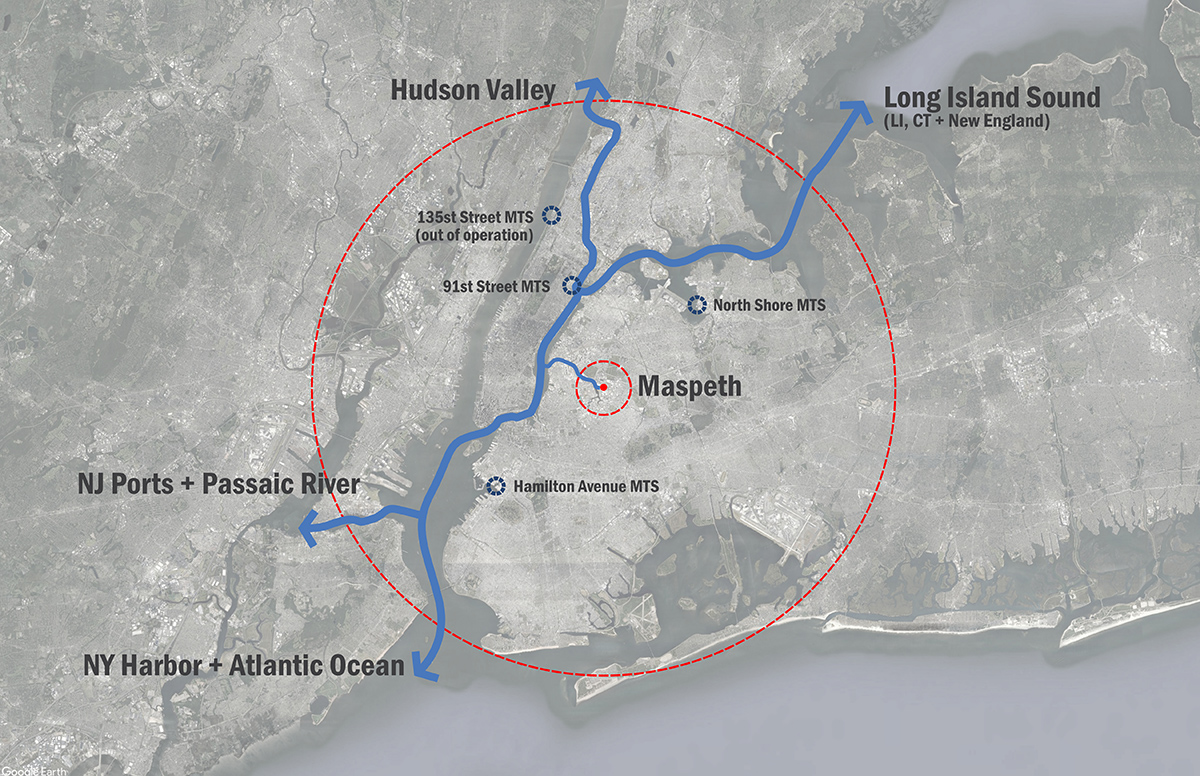
The neighborhood pilot could lay the groundwork to shape a future Green Industrial Cooperative in four phases over two to three years:
1.
Cooperative Development: Charge NYCEDC, NYSERDA, the Department of Small Business Services (SBS), the Department of Transportation (DOT), the Department of Environmental Protection (DEP), The Manufacturing and Industrial Innovation Council, and any other relevant city or state agencies with convening a coalition representing Industrial Business Service Providers (IBSPs), neighborhood businesses and residents, and other private sector actors at a quarterly forum. The short-term goal is to determine local challenges and opportunities for circular exchange of construction materials and the long-term goal is to shape a governance model for a Green Industrial Cooperative.
2.
Tactical Infrastructure and Public Realm Improvements: Led by NYCEDC, in coordination with NYSERDA, SBS, and DOT, this neighborhood pilot coalition can lead a co-design sprint to identify key locations within the IBZ to utilize and transform for material reuse purposes. These can include identifying public lots or warehouses to create reuse hubs and cost-effective transformations, from building energy retrofits to supporting micromobility infrastructure to make commuting and delivery cleaner and healthier.
3.
Provide Localized Technical Assistance: SBS could assemble a city-led technical assistance team in partnership with nonprofit IBSPs to promote material reuse and energy retrofits within the pilot neighborhood. By offering marshaled technical assistance, businesses can access incentives in a streamlined way and incorporate industrial building energy upgrades to comply with Local Law 97.
4.
Districtwide Adaptive Urban Design Guidelines: Informed by the tactical improvements and the coalition learnings, create districtwide Adaptive Urban Design Guidelines to address the long-term spatial needs within the industrial zone. These guidelines should support construction material circulation and delivery, increase green infrastructure to mitigate extreme weather impacts and reduce energy costs for businesses. Permanent street improvements could include electric vehicle charging sites, micromobility street redesigns, and reactivation of defunct freight infrastructure.
Case Studies
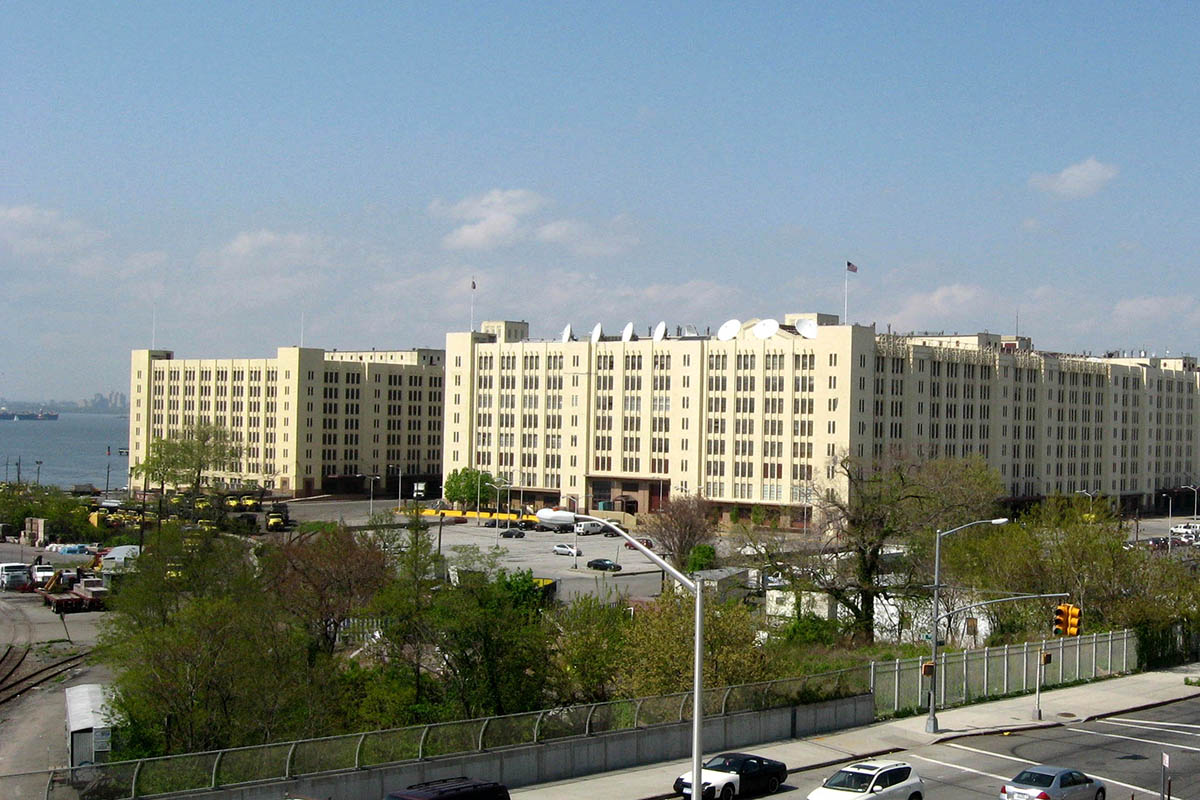
| PROJECT | OVERVIEW | IMPACT | RELEVANCE |
| Paris Logistics Hotel | Paris introduced logistics hotels in dense districts to streamline goods distribution using small-scale vehicles, reducing truck size. | Reduces vehicle miles traveled, cuts emissions and pollution, and improves local air quality and safety. | Offers a model for adapting underutilized NYC transport infrastructure as logistics hotels to enhance space efficiency. |
| Brooklyn Army Terminal | The Climate Innovation Program at BAT allows startups to test clean technologies, positioning BAT as a green economy hub. | Supports emerging companies, enhancing market resilience through collective governance. | Shows how repurposing industrial spaces for climate tech can support New York’s climate goals and promote economic growth. |
| Hunts Point Food Distribution Center | The center co-locates three markets to leverage economies of scale and support one another. | Achieves operational efficiencies and cost reductions, supports 150 businesses, and employs 8,500 people. | Demonstrates how co-op models in distribution centers can reduce waste and improve sustainability, applicable to other sectors. |
| Kings Plaza Mall | Kings Plaza Mall’s microgrid enhances local grid stability and operational efficiency while reducing emissions. | Provides lower-cost energy, generates additional revenue, and ensures operations during grid blackouts. | Highlights how microgrids can offer economic and environmental benefits while supporting community resilience. |

Gary Chung
Urban Designer, NYC Planning
Born, raised, and based in New York City, Gary Chung is a multidisciplinary designer with a background in the spatial representation, graphic composition and design research. He has worked on award-winning international and domestic projects of various scales and mediums as well as being a recipient of design and research grants that not only fueled his interest but continue to inspire him today.

Eleanor Gibson
Landscape Designer, MNLA
Eleanor is a Landscape Designer at MNLA, bringing a diverse skill set from her multidisciplinary background in landscape, urban, architectural, and interior design. Her global experience includes regional planning, neighborhood revitalization, and site design, equipping her with a unique perspective on creating resilient and vibrant urban environments. She is passionate about advancing green infrastructure to mitigate the impacts of climate change and enhance quality of life.

Earl Lin
Sustainability Specialist, Syska Hennessy
Earl Lin is a sustainability specialist with a mechanical engineering and urban data science background, passionate about sustainability and resiliency in the built environment. At Syska Hennessy, he works with building energy models to inform high-performance, energy-efficient building designs and analyze decarbonization strategies and energy conservation measures for existing buildings. As a native New Yorker, he is committed to helping New York City reach its climate goals.

Candelaria Mas Pohmajevic
Associate Director, Resilient Cities Catalyst
Candelaria Mas Pohmajevic is an Associate Director at Resilient Cities Catalyst, where she manages the Cities Forward Initiative, strengthening partner relationships with cities in the Americas to implement key resilience projects. She is an architect and urban designer focused on the integration of communities, ecosystems, and climate-sensitive infrastructures in placemaking processes. Candelaria brings extensive experience in the US, Latin America, and Europe.
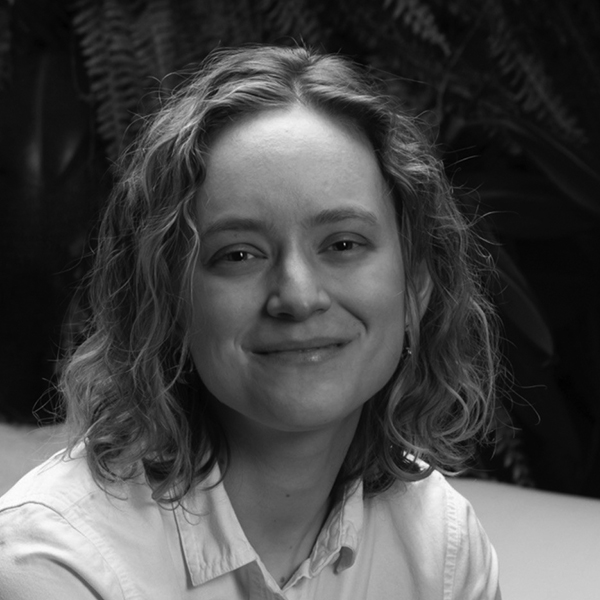
Jenny Osman
Assistant Vice President, Neighborhood Strategies, NYC EDC
Jenny Osman is a native New Yorker working as an urban planner for NYC EDC. With a background studying the built environment’s impacts on population and mental health, she is interested in advancing investments in historically redlined NYC neighborhoods that drive equitable economic growth and improve residents’ quality of life. She sees environmental resiliency, environmental justice and pollution mitigation as integral to economic development and improved health outcomes.

Saritha Ramakrishna
Senior Associate, Kyanite Partners
Saritha Ramakrishna is a writer, urban planner and researcher based in Brooklyn. As a Senior Associate at Kyanite Partners, she leads and supports projects related to community wealth building, economic development and federal funding related to decarbonization efforts. Previously, she supported advocacy around state policy for climate resiliency, transportation and environmental justice. As a freelance writer, her work has appeared in The Baffler, The New Republic, Urban Omnibus and more.

Zeineb Sellami
Senior Associate, Karp Strategies
Zeineb Sellami is an architect and urban planner leveraging multiple approaches—spatial, human-centered, and data focused—to support her passion for cities. At Karp Strategies, she leads teams through community and stakeholder engagement, workforce and economic development analyses, and urban policy strategizing across the firm’s real estate, infrastructure, and renewable energy projects. Zeineb is a WEDG Associate.

Matthew Seybert
Associate Principal, Perkins Eastman
Matthew Seybert is an Associate Principal for Perkins Eastman Architects. He is interested in developing innovative, thoughtful solutions to complex urban challenges, with a particular focus on bringing sustainable value to the communities in which he works. He has a B.Arch from the Ball State University CAP and a M.S in Urban Design from the Columbia University GSAPP.

Kristin Sposito
Project Engineer, Langan
Kristin Sposito is a project engineer in the site/civil group for Langan engineering. She is involved in design, permitting and construction for a variety of land development projects in the New York City area. With a civil engineering degree from the University of Washington, she spent most of her engineering career in the Pacific Northwest where she focused on stormwater design and modeling. Kristin thrives in multidisciplinary teams and has a passion for sustainability.
1 Gothamist. “New York City Has America’s Greatest Heat Islands—By ‘Great,’ We Mean the Worst.” Accessed August 26, 2024. https://gothamist.com/news/new-york-city-has-americas-greatest-heat-islands-by-great-we-mean-the-worst.
2 “New York City Employment Statistics” that cites “56,900” manufacturing as a of June 2024 https://dol.ny.gov/labor-statistics-new-york-city-region
3 New York City Economic Development Corporation. Data from Making It Here: The Future of Manufacturing in New York City. Accessed August 26, 2024. https://nycfuture.org/data/data-from-making-it-here-the-future-of-manufacturing-in-new-york-city.
4“Maspeth Industrial Business Zone,” IBZ Overview, accessed August 26, 2024, https://www.mibanyc.org/ibz.
Image Credit: 1. U.S. Department of Agriculture, Lance Cheung; 2. Jim Henderson